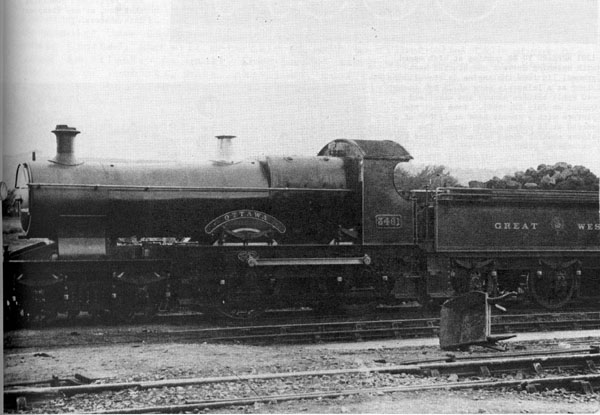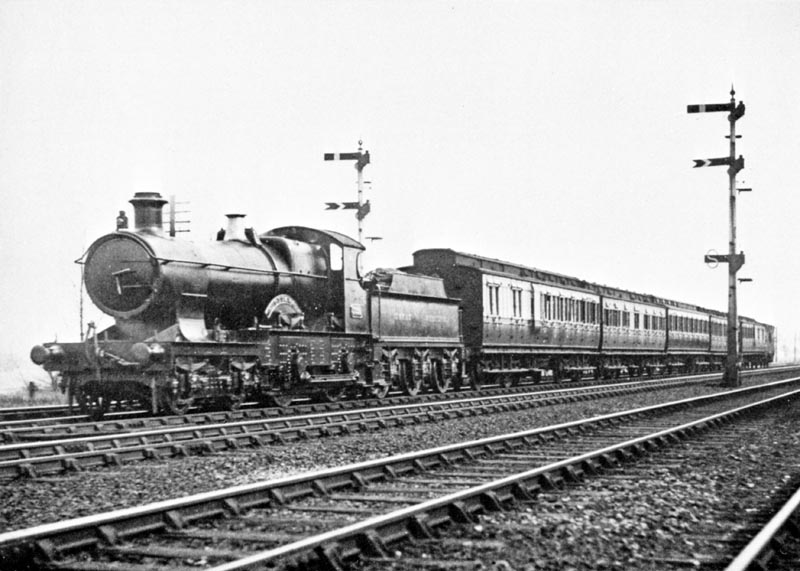|
God’s Wonderful 3461
 THE
CITY OF OTTAWA has had at least two locomotives
named after it. The first was a Bytown and Prescott Railway engine and
the
second a locomotive of the Great Western Railway in England pictured
above.
The photo shows the "Bulldog" class 4-6-0 (# 3461) in a pre-World War I
pose.
Conspicuous by its absence is the GWR characteristic copper-capped
stack
which was applied later. The nameplate "Ottawa" was donated to the city
of
Ottawa in the 1940’s. However its whereabouts today remains a
mystery. Photo thanks to John Corby.
This month's cover photograph illustrates Great Western Rail way's No. 3461 - "OTTAWA", one of a number of classes of inside cylinder 4-4-0 locomotives built by William Dean. One of its more famous cousins, CITY OF TRURO, achieved fame as being the first locomotive to have been recorded to have exceeded 100 mph. This exploit earned it a place in several railway museums, although in July 1984 it was removed from the Swindon (Holy of Holies) Museum to be put into working order for this year's "150". No. 3461 was one of the later engines of the "Bulldog" class that was built, in the 1883-1906 period. It was subsequently renumbered 3399. I have a picture of it (see below) working a stopping train from Reading to Swindon in 1926. It exhibits many of the characteristics of the GWR locomotive: 1) highly varnished paintwork; 2) brass rose safety valve cover; 3) two whistles, one for normal use and a second for emergencies.  A 4-4-0 "Bulldog" class, No 3399, Ottawa, on the 2.38 p.m. Reading to Swindon stopping train, coming into Tilehurst on 31st March, 1926. Notice the rake of clerestory stock of mixed age, with the inevitable horse box at the rear. From "Truly the Great Western" by Maurice Earley. Originally OTTAWA was not fitted with the characteristic copper capped chimney, but by 1926 this had been installed along with another typical feature - the top check valves on each side of the safety valve cover. The GWR maker's plate had also been removed by 1926 - this was located on the frame above the leading driving axle. As noted, these locomotives were double framed. Between 1936 and 1939. some 28 Bulldogs were rebuilt, with boilers from the earlier "Duke of Cornwall" class. The new lower pitched boilers with large steam dome changed the look of these interesting machines. The hybrids were naturally known as "Dukedogs", however, I don't believe OTTAWA was treated thus. Our cover picture dates from before World War I. The GWR crest on the tender was subsequently replaced by a more simple design that lacked the ermine and garter. The engine is carrying headlamps in the express passenger position, one at either side of the buffer beam. Over the years, the nameplat.es were removed from a number of these engines. Some were named after towns served by the GWR which felt that passengers would confuse the name of the locomotive with the destination of the train. The GWR stretched its tentacles a long way but it never had any services to Ottawa so it felt it safe to retain the OTTAWA plate. Incidentally. No. 3400 was named WINNIPEG while No. 3401 was named VANCOUVER. No Bulldogs were preserved; the last one was withdrawn in 1951. The Dukedogs soldiered on into the preservation era and their last haunts were from Machynlleth on the Cambrian section. Happily one, No. 9017, has been preserved in working order on the Bluebell Railway. Nominally a new engine in 1936, No. 9017 was built from parts from No. 3258 built in 1895 and No. 3425 built in 1906. |